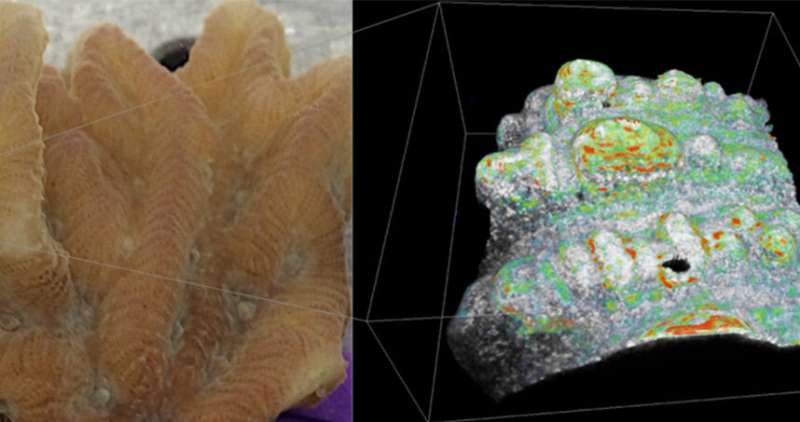New imaging platform examines mechanisms behind coral bleaching

As coral reefs deteriorate in the face of climate change, an interdisciplinary Northwestern Engineering research team has developed an innovative method to image coral nanoscale structures and quantify pigment absorption in live corals, an indicator of coral health. The imaging platform could become a valuable tool to help marine biologists better understand coral physiology as well measure and monitor coral health.
Reef building corals provide a home to more than 1 million species in our oceans. Yet increasing ocean temperatures have given rise to coral bleaching, a phenomenon where corals expel their life-providing algae, jeopardizing the health and sustainability of colonies.
"Coral reefs provide critically important ecosystems, but they are bleaching at alarming rates due to global warming," said Luisa Marcelino, research assistant professor of civil and environmental engineering at Northwestern Engineering. "In order to develop strategies to prevent coral reef death, it is critical to understand the mechanisms of bleaching. However, there are no current means to image live coral tissue due to the complexity of its structure."
The team from the McCormick School of Engineering published its insights in a paper titled "Measuring Light Scattering and Absorption with Inverse Spectroscopic Optical Coherence Tomography (ISOCT): A New Tool for Non-invasive Monitoring" on October 2 in the journal Scientific Reports. Marcelino served as the co-corresponding author of the study along with Vadim Backman, Walter Dill Scott Professor of Biomedical Engineering.
The research expands upon Marcelino and Backman's previous work studying coral, which includes developing a quantitative coral bleaching response index in 2016. The first database of its kind, the index used historical data to measure the statistical mass density distribution of coral skeletons, a trait tied to bleaching susceptibility. The index also detailed which of the world's coral species are most at risk of bleaching and most likely to perish as a result of thermal stress caused by warming oceans.
When the coral index was created, the team couldn't image coral samples non-invasively. The new imaging technique, called inverse spectroscopic optical coherence tomography (ISOCT), uses lasers to scan living coral and measure its optical properties at full 3-D resolution.
"We originally developed ISOCT to image human tissues in order to better understand alterations in early carcinogenesis," said Backman, who leads Northwestern's Center for Physical Genomics and Engineering. "We had to adapt and enhance it for coral imaging, which produced an exciting example of cross-pollination in science and technology."
Not only does ISOCT provide greater clarity into the statistical mass density distribution of the skeleton and tissues of different coral species, it also quantifies the chemical concentration within coral, including levels of chlorophyll and other fluorescent pigments.
"Corals have adapted through evolution to harvest light in a specific way. As the environment changes and oceans get warmer, the ability to adapt to those changes might be affected by their basic physiology," said Graham Spicer (Ph.D. '19), a co-first author on the study and former Ph.D. student in Backman's lab. "ISOCT provides spatially-resolved information, so we can study exactly how species of coral might adapt better than others to environmental changes."
By illuminating new insights into how coral adapts to environmental stresses, the team believes ISOCT could help marine biologists create new strategies to protect particularly susceptible species from bleaching due to climate change.
"The new imaging technique provides the first comprehensive analysis of the structure and function of live corals, which is a critical step toward better understanding how corals bleach and die," Backman said. "Understanding these processes may help design strategies to slow down or prevent coral bleaching."
Spicer added that a greater understanding of corals could also present new opportunities on another environmental front—solar capture.
"Corals have adapted over millions of years to harvest light in an optimal way given their environment," Spicer said. "If we could fully understand the mechanisms by which corals have been optimized via evolution to harvest light, we could develop similar strategies as the basis for solutions to harvest solar energy."
More information: G. L. C. Spicer et al, Measuring light scattering and absorption in corals with Inverse Spectroscopic Optical Coherence Tomography (ISOCT): a new tool for non-invasive monitoring, Scientific Reports (2019). DOI: 10.1038/s41598-019-50658-3
Journal information: Scientific Reports
Provided by Northwestern University



















